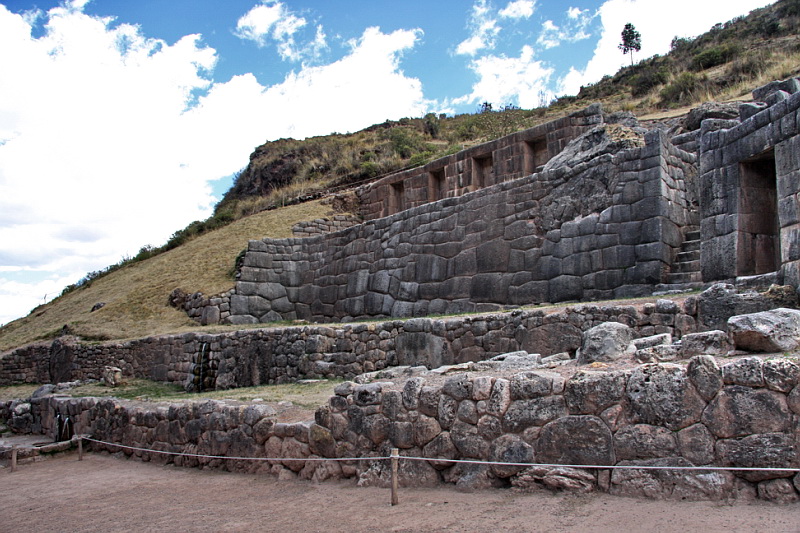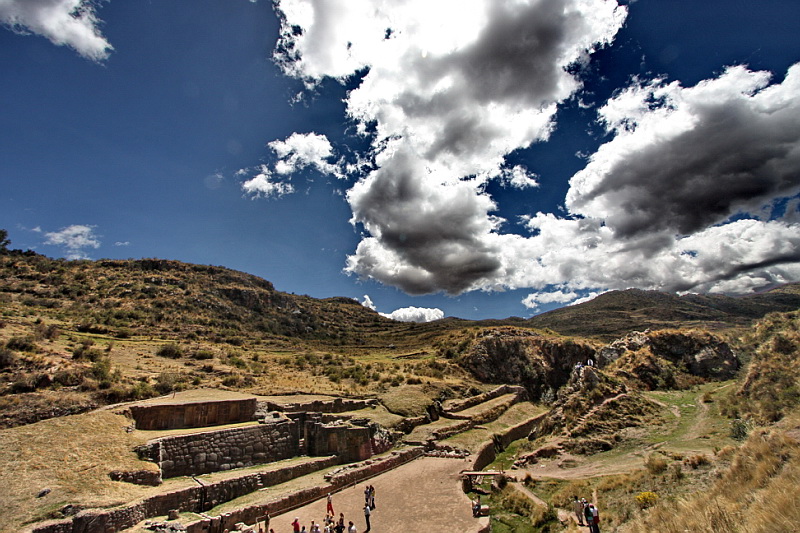Tambomachay or Baths of the Inca

The archaeological site of Tambomachay is located at 8 km (15 minutes) to the northeast of Cusco, by asphalted road; and at 1 km of Puca-pucarб. It is located at a foothill near the main road to the Antisuyo, overt the Tambomachay River. It is also known as Tambo de la Caverna (Cave Roadside Hostelry) and occupies an area of 437 square meters, located at 3,700 meters of altitude.
Apparently, it was one of the favorite resting-places of the Incas, used as a resting watering place and, at the same time, it was one of the pillars of the defense system of the Valley of Cusco.
Its name derives from two Quechua words: Tampu, which means collective lodging; and Mach'ay, which means resting-place. However, according to other references, the word "machay" means "caves", which would describe the particular environment of the place in where it is possible to appreciate these natural rocky formations that, according to the indigenous tradition, were object of worship or magical customs.
It is composed of a set of stone structures finely carved, aqueducts and water falls originating from near springs and thermal sources; that is why people think it was related to the worship of water, one of the pillars of the Andean conception of the world. It is considered one of the Indian temples of the first Antisuyo ceque.
According to the chronicles, it was the game preserve of Inca Yupanqui, which makes us think that it was an area rich in animal species.

It also known as "Baсo de la Сusta" (Bath of the Сusta) or "Balneario Inca" (Incan Watering Place). The monument is remarkable due to its architectonic excellence. We can appreciate four walls or graded terraces embedded to the hill, made of irregular carved-stone polyhedrons, brilliantly assembled, and which make up three parallel cultivation terraces. A thick wall (15 meters long and 4 meters high) decorated with four niches erects on the last polyhedron. The stones had been perfectly adjusted. It has four large trapezoidal niches of 2 meters on average. In front of the building there was a circular large fortified tower that must have had defense and communication aims.

The water itself was worshiped as the source of life. Tambomachay has an extraordinary hydraulic system. Two aqueducts, artistically carved on the rock, transport and keep a constant flow of clean water during the whole year, which comes from a large puddle located at a higher level. This network of underground channels pours its waters in a small stone puddle situated at the lowest level. This puddle had to be a liturgical spring, where the Inca worshiped the water with the noblemen of the Empire.
The "Baсo de la Сusta" is very similar to that of Ollantaytambo, made of stones perfectly assembled, with carved edge and drainage gutters. Even though it is now an opencast work, the foundations seem to indicate that it was a closed precinct originally. We enter through four trapezoid portal platforms with double jamb.
If you look the monument from the river you will be able to see two thick walls that cut the support wall. The wall that faces the river has two big niches and the other, almost perpendicular to the first one, has a door with double jamb. This kind of door was used by the Incas to stress the significance of a place. Through that door we get to a small room in which we can see the water that springs from the bowels of the Earth.
So far we haven't been able to discover the origin of the spring that supplies such clear and abundant water to the sources. Some people think that the slight slope in where the site is situated does not have the capacity to produce said water and that it can come from the opposite bank of the river. However, the one thing that cannot deny is the perfection of the channel carving. The sound of the water, the quietness and peace of the environment, as well as the closed and secluded form of the space in which it was constructed, give Tambomachay a peculiar atmosphere. Besides, it is a great sample of the skills of Andean architects to harmonize constructions and landscape.